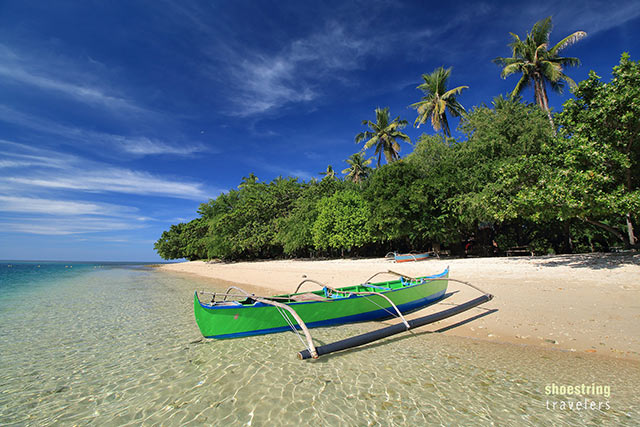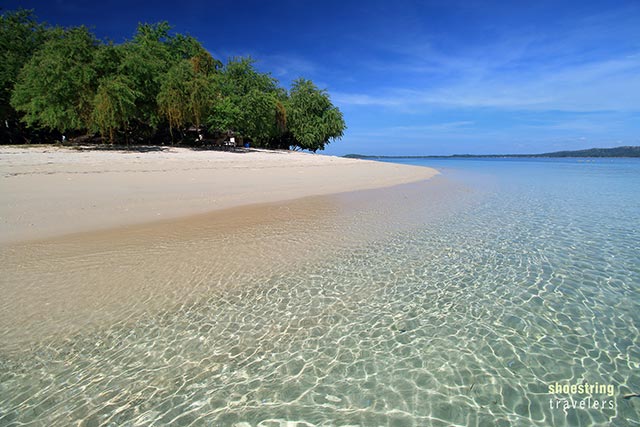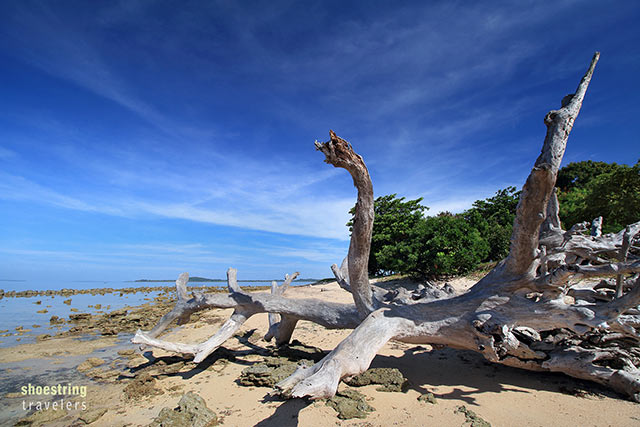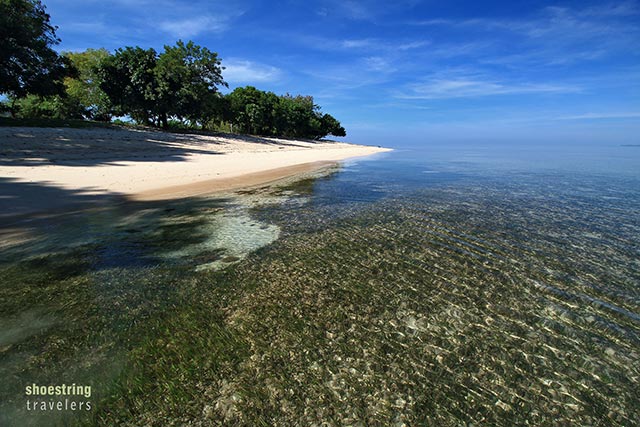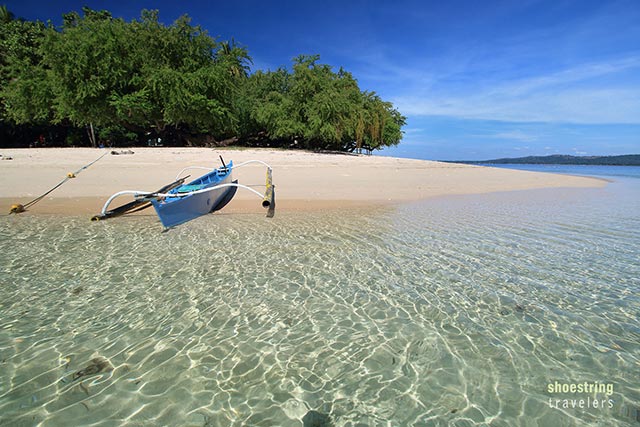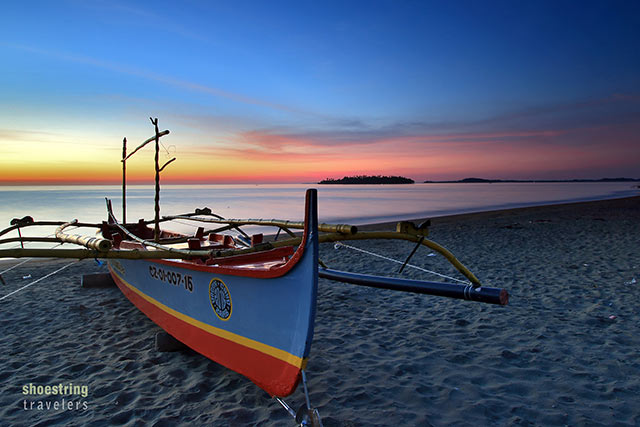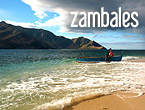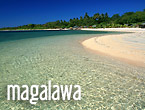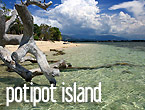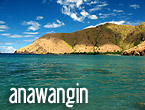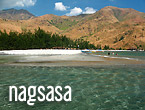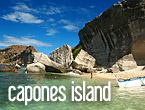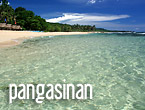Potipot Island, Zambales (Updated)
From the mainland of Zambales, the island looked so near that we thought we could easily cover the distance using a kayak but for the moderately strong waves. And sure enough we had scarcely boarded our motorized outrigger when, within minutes, we were almost on the island. The dark blue sea soon transformed to turquoise green, then to crystal-clear water gently lapping at the soft, fine, creamy white sand as our boat slowly came to a stop on our island destination’s eastern beach.
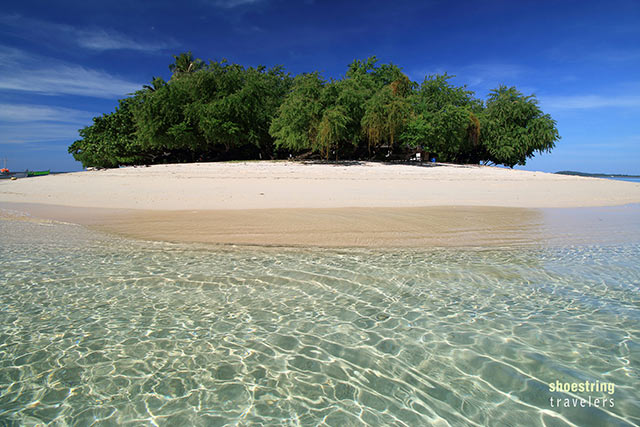
Crystal-clear waters and a creamy white sand beach greets the visitor at Potipot Island.
Potipot island in Uacon, Candelaria, Zambales had been around our travel radar for years but we had never seriously considered going there until recently. On a drive home through Zambales from Tondol Beach in Anda, Pangasinan last year we encountered people on the highway with signs advertising boat trips to Potipot. We decided we wouldn’t allow this year to pass without paying a visit. Our original plan was to visit the island as part of a return trip to Dasol in Pangasinan but we ended up visiting Potipot on a one-day trip instead.
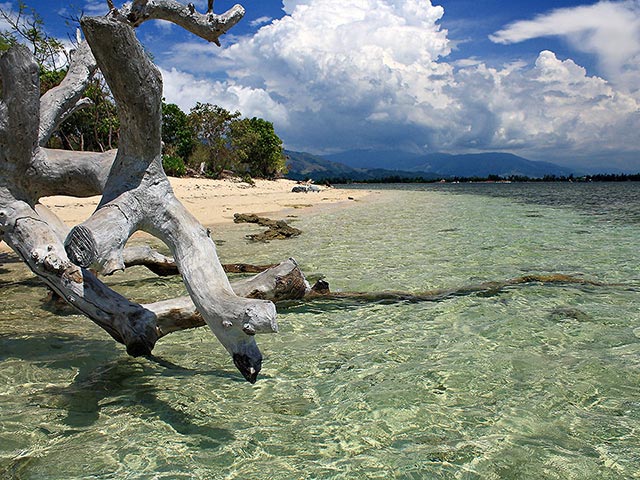
Driftwood on Potipot; the hilly Zambales mainland, just a 5-10 minute motorized banca
boat ride away is easily visible in the background.
Potipot has got to be one of the most accessible islands we’ve visited in the country. From Uacon in Candelaria and just a short distance off the main highway, one can get a motorized banca or outrigger boat and travel to the island in 5-10 minutes. Potipot has also become more popular in recent years. We were fortunate enough to have traveled on a Monday; the place is said to be packed with tourists on weekends. Fortunately, the island is still relatively pristine. There are no resorts on Potipot itself although there are a few huts for rent should one want to stay overnight. There are basic toilets and shower rooms (but no showers – one has to fetch water from a deep well for bathing) as well as tables and benches for small groups that come with the entrance fee to the island.
With its warm clear waters, soft sand and gradually sloping beach, Potipot is ideal for swimming. It seems that people maintaining the island keep it free from sea grass. (Unfortunately there are hardly any corals in the area near the picnic tables making snorkeling here a bit of a disappointment.) There’s abundant shade on the island as well, which on this hot and humid April day was just perfect for us. We dined on one of the many tables under the cool shade of the trees and pretty much lazed away the afternoon resting here and swimming in the warm waters a short walk from our picnic area.
Potipot is just 7.5 hectares in size, surrounded by a creamy white sand – some say pinkish white sand – beach throughout. It is possible to walk around the island in 30 minutes. We believe the best spot in the island is the southern part where one encounters the famous driftwoods and isolated portions of beach where the sand is finer and the water is even clearer. The area near the driftwoods also contains some coral rocks leading us to surmise that there could be fishes here; unfortunately we had left our snorkel at our picnic table which is a good distance from this place. Few, if any people stay here. There are no tables or benches probably because the shade here is not as good compared to the area where we had our lunch – making it the perfect place for moments of quiet solitude. Leo also found it to be the best place for taking photos.
Tips
You can get a boat to Potipot from Uacon in Candelaria at any of the resorts there or from boatmen in the area. We parked in a private lot (for a fee of P100) and got a boat from the caretaker of the place. Boat fees are P400 for a boat that can take 4 people and P500 for larger ones that can take 7. Make sure to bring your own food. The lone store on the island only sells snacks and beverages. There is an entrance fee to the island (we heard it’s privately owned): P100 for a day trip and P300 for an overnight stay. There are small, native-style cottages for rent. There is no electricity on the island. Some people choose to stay at the resorts in Uacon and make a day trip to Potipot. We chose to go up to Zambales from Metro Manila in the morning, stay at Potipot in the afternoon and make the return trip back to Manila, all in one day. Not good for Leo’s back since he was driving all the way.In retrospect, we think it would have been far better to do this trip, given its distance from Manila, as part of a longer visit to other destinations in Zambales or Pangasinan as we had originally intended. Or, at the very least, we could have stayed overnight at one of the resorts in Uacon (the resort list includes Sunbloom Resort, Dawal Beach Resort and Puerto del Mar among others). A drive to Candelaria and back in one day is a bit too much for a leisurely trip. (We stayed overnight at Dawal Beach Resort and made the trip to Potipot the following morning on a recent visit.)
Getting To Uacon, Candelaria
By private vehicle: To get to Uacon, Candelaria by car take the North Luzon Expressway (NLEX) all the way to the Dau/Mabalacat exit then continue on to the Subic-Clark-Tarlac Expressway (SCTEX). The route through San Fenando – Lubao in Pampanga is shorter but passes through a narrower road and congested town centers so we decided on using the SCTEX instead for speed and ease of travel. Travel the length of SCTEX to the Tipo Exit, pass through the Subic Bay Metropolitan Authority (SBMA) and on to Subic Town. Take the national road all the way to Candelaria. You will pass by the towns of Castillejos, San Marcelino, San Narciso, San Felipe, Cabangan, Botolan, Iba, Palauig and Masinloc before Candelaria in that order. It’s about a five hour drive from Metro Manila. There are two things to remember so your trip doesn’t take longer than necessary:1. After Castilejos you will reach a junction with a sign on the road going to the left pointing to San Antonio. Do not enter that road but continue straight on to San Marcelino and San Narciso to avoid passing by San Antonio which is the longer route (the road to San Antonio goes to Pundaquit and the destinations of Anawangin and Nagsasa Coves).
2. There is another junction after Iba and before Palauig. The road to the left goes to Palauig town proper. Do not take that but take the road inland (to the right) that bypasses Palauig town and goes straight to Masinloc and on to Candelaria.
By public vehicle: Ride a bus bound for St. Cruz, Zambales. Victory has buses that regularly ply this route. Get off at Barangay Uacon in Candelaria (Candelaria is the town just before Sta. Cruz). You can take a trike or even walk to the nearest resort or the beach where you can get a boat to Potipot Island.
Visit our Flickr and Facebook pages for more pictures of Potipot Island.

